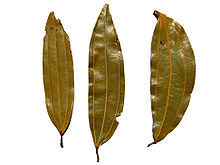Malabathrum
This article needs additional citations for verification. (June 2009) |
| Malabathrum | |
|---|---|

| |
| dried Malabathrum leaves | |
| Scientific classification | |
| Kingdom: | |
| (unranked): | |
| (unranked): | |
| Order: | |
| Family: | |
| Genus: | |
| Species: | C. tamala
|
| Binomial name | |
| Cinnamomum tamala (Buch.-Ham.) Nees & Eberm.
| |
Malabathrum, also known as Malobathrum or Malabar leaf, is the name used in classical and medieval texts for the leaf of the plant Cinnamomum tamala (sometimes given as Cinnamomum tejpata) [citation needed]. In ancient Greece and Rome, the leaves were used to prepare a fragrant oil, called Oleum Malabathri, and were therefore valuable. The leaves are mentioned in the 1st century Greek text Periplus Maris Erytraei as one of the major exports of the Malabar coast which is the present Kerala coast. In the language of Kerala that is, Malayalam, the plant is called 'Vazhana'. It is also known as 'Karuva' in Malayalam. The name Malabathrum is also used in mediaeval texts to describe the dried leaves of a number of trees of the genus Cinnamomum, which were thought to have medicinal properties.
Nomenclature and taxonomy
This section needs expansion. You can help by adding to it. (June 2009) |
Characteristics

The leaves, known as tejpat in Nepali, tējapattā or tejpatta (तेजपत्ता) in Hindi, Tejpat in Assamese and tamalpatra in Marathi, are used extensively in the cuisines of India, Nepal, and Bhutan, particularly in the Moghul cuisine of North India and Nepal and in Tsheringma herbal tea in Bhutan. It is called Biryani Aaku or Bagharakku in Telugu. They are often erroneously labeled as "Indian bay leaves," though the bay leaf is from the Bay Laurel, a tree of Mediterranean origin in a different genus, and the appearance and aroma of the two are quite different. Bay leaves are shorter and light to medium green in color, with one large vein down the length of the leaf;photo while tejpat are about twice as long and wider than laurel leaves. They are usually olive green in color, may have some brownish spots and have three veins down the length of the leaf.photo True tejpat leaves impart a strong cassia- or cinnamon-like aroma to dishes, while the bay leaf's aroma is more reminiscent of pine and lemon. Indian grocery stores usually carry true tejpat leaves. Some grocers may only offer Turkish bay leaves, in regions where true tejpat is unavailable.

List of the cultivars and their nommenclature
This section needs expansion. You can help by adding to it. (July 2009) |
Aroma attributes
- Eugenol [1], [2]
- Beta-Caryophyllene [3] [clarification needed]
- Linalool [3] [clarification needed]
- Caryophyllene oxide [citation needed]
Uses
The bark is also sometimes used for cooking, although it is regarded as inferior to true cinnamon or cassia [citation needed].
Etymology
"Malabar" is the name of a region on the west coast of southern India that forms the northern portion of the present-day state of Kerala. The word "Mala" or "Malaya" means "Mountain" in the Tamil and Malayalam languages, as also in Sanskrit. The word "Malabathrum" is also thought to have been derived from the Sanskrit tamālapattram (तमालपत्त्रम्), literally meaning "dark-tree leaves."
Toxicology
This section needs expansion. You can help by adding to it. (June 2009) |
Related species
Notes
- ^ Dighe, V. V.; et al. (2005). "Quantitative Determination of Eugenol from Cinnamomum tamala Nees and Eberm. Leaf Powder and Polyherbal Formulation Using Reverse Phase Liquid Chromatography". Chromatographia. 61 (9–10): 443–446. doi:10.1365/s10337-005-0527-6.
{{cite journal}}:|access-date=requires|url=(help); Cite has empty unknown parameter:|coauthors=(help); Explicit use of et al. in:|first=(help) - ^ Rao, Chandana Venkateswara; et al. (2008). "Antidiarrhoeal activity of the standardised extract of Cinnamomum tamala in experimental rats". Journal of Natural Medicines. 62 (4): 396–402. doi:10.1007/s11418-008-0258-8.
{{cite journal}}:|access-date=requires|url=(help); Cite has empty unknown parameter:|coauthors=(help); Explicit use of et al. in:|first=(help) - ^ a b Ahmed, Aftab; et al. (2000). "Essential oil constituents of the spice Cinnamomum tamala (Ham.) Nees & Eberm". Flavour and Fragrance Journal. 15 (6): 388–390. doi:10.1002/1099-1026(200011/12)15:6<388::AID-FFJ928>3.0.CO;2-F.
{{cite journal}}:|access-date=requires|url=(help); Cite has empty unknown parameter:|coauthors=(help); Explicit use of et al. in:|first=(help)
